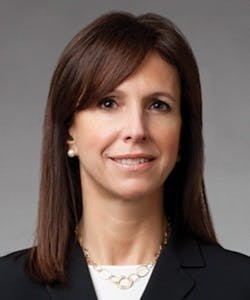Alistair Erskine, M.D., has held various roles within healthcare leadership throughout his career. As he has been practicing hospital medicine for nearly 15 years, Erskine has also been climbing up the clinical leadership ranks, becoming chief medical information officer (CMIO) at Virginia Commonwealth University (VCU) Health System, before being appointed associate dean of medical informatics there. Now at the Danville, Pa.-based Geisinger Health System, Erskine, who is also board certified in clinical informatics, holds the role of chief informatics officer—different from the CMIO and different from the CIO (chief information officer).
“Ironically, we are not for a lack of CIOs at Geisinger; we have four of them,” Erskine jokes, referring to the titles of the four “CIOs” at the integrated Geisinger Health System with 1,600 employed physicians, 12 hospital campuses, and serving some 3 million patients: chief informatics officer; chief innovation officer; chief information officer; and chief integration officer. Indeed, as traditional roles inside the C-suite are now evolving and in some cases, transforming, Erskine admits that as the healthcare landscape becomes more consumer-centric and technology-focused, it’s no longer business as usual when it comes to organizational leadership.
“When I was CMIO at VCU in 2005, that was still a pretty new position,” Erskine recalls of his time at Virginia Commonwealth University in Richmond, Va. “The kinds of things in the job description for that role were being politically savvy, being a clinical and IT double agent, understanding clinical workflow, having empathy for doctors, understanding technical capabilities, and seeing how to connect the dots between the two,” he explains. There was also the design configuration of EHRs (electronic health records) and compliance with Meaningful Use, he adds. “That was the typical set of activities for the CMIO. So you ended up being the doctor in the IT department, helping them realize what they needed to turn on and off. Whether or not a CMIO is a good idea inside an organization is not a debate anymore. You need a doctor who knows something about IT to work with your CIO,” Erskine says.
Alistair Erskine, M.D.
New Roles, New Skillsets
But now, the focus inside healthcare organizational leadership is again shifting, this time to areas around optimization, transformation and innovation. And with that shift is the evolution of the chief informatics officer position, or sometimes called the chief health informatics officer (CHIO), says Hillary Ross, a principal with the Oak Brook, Ill.-based executive search firm Witt/Kieffer. Ross, who specializes in the recruitment of senior-level physicians and other clinicians, and who conducts searches for CMIOs and CHIOs, reiterates Erskine’s thoughts that first generation CMIOs were liaisons and translators between the clinical and technical staff. They were seen as the bridge between the IT department and the clinical community. They facilitated implementation of EHRs, and trained the clinicians on those systems, she says.
The CHIO, Ross says, needs to be a new position with different skills from those of the CMIO. Ross wouldn’t call the position the “CMIO 2.0,” instead referring to the role as the “data-driven CMIO.” In other words, while CMIOs can become CHIOs, there are additional skills that will be needed, she says. “Now that these systems that organizations have spent millions of dollars on are generating lots of valuable data, the conversation turns to, ‘What are we going to do with this data?’ It’s about taking the data and turning it into actionable knowledge. That’s a big difference between the CMIO and the data-driven CHIO,” Ross says.
Erskine wouldn’t call the new informatics role in the C-suite a CMIO 2.0 either, saying if anything, it’s more like a CIO 2.0. “If you apply three different lenses onto an organization—the technical lens, the political lens, and the cultural lens—the CMIO was primarily focused on the technical lens with win-win advantages by configuring the system one way and having doctors be happy about it. But as the role evolves, the political and cultural lenses become much more important,” Erskine says. “You have to learn how to manage scarce resources that you are responsible for, allocate them appropriately, and compete for other resources. This requires more savviness.”
Erskine, who has been in the chief informatics officer role at Geisinger for about three years, says that it has evolved into a position with various functions. “You have the data analytics for the organization, so the kinds of things a chief data officer would typically oversee, and then you have the clinical information systems, so the things a CMIO would oversee, and then you have the CNIO [chief nursing informatics officer] who tends to have more of a role with the backend of a system, and all of those roles—as well as the chief research information officer—essentially roll up to the new chief informatics officer. This role is much more around strategic planning for the organization, using IT as a strategic asset,” he says. Witt/Kieffer’s Ross adds that the new position “will require leadership, innovation and transformation by someone who can set and drive strategy.”
Hillary Ross
To this end, this shift in focus in the healthcare C-suite has also led to shifts in salaries. A recent survey from Cejka Executive Search in partnership with the American Association for Physician Leadership found that the greatest increase in C-suite compensation since 2013 was 18 percent for physicians in the chief information officer or chief medical information officer roles. The double-digit increase for CMIOs/CIOs is likely due to the roles’ shift in focus—from EHR implementation to ensuring the usability of data to support preventative care at the individual provider level and risk-based accountable care at the enterprise-level, according to the report’s authors. “Clearly, there is perceived value in having a physician leader drive these initiatives and facilities are willing to compensate accordingly,” Paul Esselman, Cejka Executive Search’s senior executive vice president and managing director, said in a statement accompanying the survey.
Indeed, leading health systems such as Geisinger, Cleveland Clinic and Mayo Clinic that are very clinically-driven will put clinicians in those leadership roles on purpose, says Erskine, who adds that other organizations might not have the same priorities for leadership positions. But, he notes, at Geisinger, almost all leadership roles are mapped to an administrative non-clinician. “The idea was that clinicians have good ideas but they do not always make the best administrators. So why not have a clinician who is rising through the C-suite ranks have a vice president or executive vice president partner in what he or she is doing? This satisfies the need for getting consensus across a broad group of different people," he says.
Collaboration is Key
In organizations across all industries, much is often made about reporting structures and hierarchies. Witt/Kieffer’s Ross emphasizes that every organization is different, and her firm is seeing this new CHIO position report to the CEO or the COO (chief operating officer), and in some instances the CMO (chief medical officer), but no matter what, is almost always a peer to the CIO. At Geisinger, there are two layers of leadership reporting, with six people reporting to the CEO and then a group of 12 reporting to those six people, says Erskine. “Titles can be cheap. The CIO and I do have signature authority over 4 percent of our $6 billion health system budget. Even though our lines don’t go straight to the CEO, it hasn’t ended up being necessary,” he says, adding that he meets with the CEO on a monthly basis, so the relationship is the same as it would be if he directly reported to him, even though it doesn’t look that way on paper.
Regardless of the reporting structure, collaboration among individuals is what’s most critical, attests Tim Tolan, senior partner at the St. Augustine, Fla.-based Sanford Rose Associates’ healthcare IT practice. “In the way [these positions] work together, there has to be collaboration or it won’t work,” he says, speaking to the CIO/CMIO relationship. “Either way, the CMIO has to have a seat at the table. With the way healthcare is now, with analytics, population health, and all of that, there is not enough time for people to sit on an island on their own. It simply won’t work,” Tolan says. Sanford Rose is currently working on a search for an organization in which the CMIO reported to the CIO, which Tolan says has been fairly typical based on the organizational chart and where the CMIO fits on it. “But in this case it didn’t work. More and more CMIOs today, and going forward, are going to report to the CMO, someone who has the clinical leadership. The role is becoming very strategic,” Tolan says.
Tolan expands further on the CIO/CMIO relationship, noting that it used to be that the CIO would get relegated to “the older stuff” and financial systems, while the CMIO would get to work on the fancy Epic implementation or the new analytics platform. “That didn’t work due to a lack of collaboration,” Tolan says. “So the CIO role today is much more entrenched to the overall strategy of the facility. The two roles count on each other and need to be in lockstep. The lines of demarcation are gone. I see a much more closely aligned relationship now,” he says.
To this end, while the technical and clinical expertise is obviously a must for these positions, the “softer skillsets” to bring those diverse groups together that have separate interests are also critical, says Eric Dickerson, managing director and senior practice leader at Kaye/Bassman International, a Plano, Texas-based search firm that acquired Sanford Rose three years ago, now together representing one of the largest of its kind in the U.S. “You need to be able to say that we’re creating something that will be bigger than the sum of its parts. So that means being able to collaborate and work well, and not having the CIO with infrastructure in these key areas and the CMIO in these clinical areas. Instead, you need to bring it all together and cross-pollinate. It can’t happen in siloes,” Dickerson says.
A Forward-Thinking Future
Going forward, Erskine feels it’s important that folks in the CMIO or CIO roles currently have alternative career options if they so choose. He references an annual survey from research and advisory firm Gartner that asks CMIOs about their future goals. “The answer typically ends up being that they want to stay as CMIOs since they are comfortable in that role. Or maybe they want to become a CMO,” Erskine reports. “But there is another option, the chief informatics officer,” he continues. “The traditional CIO has been worried about making sure that the network and software are adequate, and the CMIO has been primarily worried about the EHR. This new world of chief informatics officer gets to take the EHR effort, add to it the data warehouse or analytics effort, and look towards the future for major platforms that may not exist in healthcare but should.”
Erskine gives an example of this: the customer relationship management (CRM) platform where there is more of an engaged stickiness of a customer who’s a patient or member of a health plan. “That direction doesn’t exist right now, but you see what Amazon, Netflix or Uber offer, and someone needs to design that for healthcare [from a] customer-centric approach,” he says. “We all work for the patient, but CMIOs are also working for doctors who are ultimately helping the patient out. Now you [can have] a chief informatics officer looking into the future thinking about how does my patient, member or customer interact with my health system as a whole? What are their preferences for communication and interaction? So there are consumer aspects as opposed to just medical aspects,” Erskine says.
For candidates looking to apply for these healthcare leadership positions, Ross says they should look to continue to add to their expertise by looking at analytics through a board certification of informatics, as well as joining organizations such as the American Medical Informatics Association (AMIA) and the Association of Medical Directors of Information Systems (AMDIS) where candidates can take advantage of their educational committees. And if someone is interested in transitioning to a CIO, the development of business skills will be crucial, Ross notes.
Tolan adds that candidates need to understand that hospitals and health systems are looking for individuals who have “phenomenal people skills and are truly strategic in the way they think.” He notes, “It’s important for CMIOs to maintain who they are—physicians. In the end, they have to be able to come in and prove they have the ‘EQ’ as much as the IQ and the knowledge of the role,” he says. “If you cannot have a dialogue, if you cannot articulate or strategize with the very people the hospital is counting on you to engage, it won’t work. And you have to demonstrate these traits in the interview,” he attests.
Tolan and Dickerson further say that there is not a huge pool of these candidates that have the depth and breadth of knowledge and expertise. As such, when an organization is looking to hire, it will have to assess people and move them through the hiring process much faster than before. “The market is changing; these candidates are in heavy demand,” Tolan says. “If you do a four or five month search, you’ll lose candidates every two to three weeks. You have to set boundaries and keep the search moving.”




